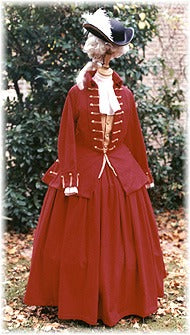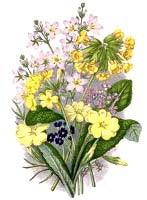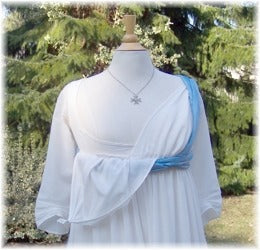Miss Crawford's enjoyment of riding was such that she did not know how to leave off.--Mansfield Park
Ladies' clothing specifically for riding was not introduced until the second half of the sixteenth century, when protective overskirts or 'safeguards' were worn, together with cloaks, hats, boots, and masks to guard the complexion. Before that, women wore their everyday dresses on horseback. In the 1640s Queen Henrietta Maria was painted wearing a hunting dress and by the early eighteenth century the riding costume was established.

 Dates of costumes, left to right: 1715 and 1790
Dates of costumes, left to right: 1715 and 1790
The first habits followed the fashion of men's attire, quite often adopting styles of military uniforms, and as equitation was considered an art and a courtly pastime, elaborate trimmings and materials were used, such as the brocades of the Restoration period and beyond. Designs were heavily influenced by the French court, but as the eighteenth century progressed, the English hunting country gentleman was a major inspiration, and habits became plainer cut and more functional.
 1770 Colonial habit
1770 Colonial habit
This eighteenth-century reproduction habit was made in red wool from the 1770 Colonial habit dressmaking pattern available from Side Saddle Lady (P8). Instead of the closure shown in the pattern, Side Saddle Lady cut 1 inch or so off the front, faced it, and folded it back from neck to waistline (top and bottom seams of the foldback were angled to match the line of the jacket), and added gold rope trimming and buttons, in a style similar to an original habit in the Victoria and Albert Museum in London. Hemlines at this time ranged from floor length to a few inches off the ground. This habit is displayed with a hoop petticoat. The dressmaking pattern also includes a false waistcoat and a neck frill (see pictures below - colour of red habit differs, as the pictures were taken at different times, in different light!). Our waistcoat was made in a gold/buff material with a damask pattern; the frill was in white cotton.

 Dates of costumes, left to right: 1818 and 1830's
Dates of costumes, left to right: 1818 and 1830's
Around 1785, the riding coat (later redingote) appeared with its close-fitting bodice, double or triple cape-collar in the style of a coachman's coat, and a buttoned skirt. At the end of the century styles changed again and by the early nineteenth century a less voluminous habit became fashionable, with a high waistline and often a pleated jacket back, using materials such as fine wools or nankeen in the summer (there is also some evidence for velvet). The style lasted through the Regency period but began changing dramatically after the 1820s, when skirts became fuller again, and sleeves puffed. By the 1830s, the large, dropped-shoulder 'gigot' sleeves were popular. These were fairly short-lived, but the bulbous skirts remained throughout the mid-nineteenth century, accompanied by jackets with large peplums.
 Regency riding habit
Regency riding habit
This reproduction Regency riding habit c. 1818 was made from various pieces of the Regency Wardrobe dressmaking pattern, available from Side Saddle Lady (P10). Although made in this instance in honey-coloured velvet, the style would originally more likely have been made in a fine wool material, or cotton nankeen for summer use. The jacket lends itself to military-style trimming. Changes from the pattern in the Side Saddle Lady example were a shortening of the back peplem on the jacket and narrowing of the sleeves towards to the cuffs. The hat (see picture below) was adapted from the one given in the Regency Wardrobe pattern, made smaller, and with a peak and tassels added. The pattern for the cream cotton chemisette with frilled collar is also given in the Regency Wardrobe dressmaking pattern (the cuffs were made separately and attached to the sleeves on the inside).


Dates of costume, left to right: 1858 and 1873.
Later riding fashions
The tall and slender elegance of equestriennes such as Empress Elizabeth of Austria, who was sewn into her riding costume every morning she hunted, saw fashions changing again to the slimline darker-coloured habits of the 1880s with their high-buttoned bodices and jacket tails and trousers rather than petticoats, and thence to the 1890s with longer jackets and 'leg of mutton' sleeves.

The early twentieth century saw habits with flared, long-line jackets and patented safety skirts. The first safety skirt had been introduced in about 1875, but the design by Alice Hayes at the turn of the nineteenth century, with the length of skirt unbuttoning, gradually evolved into the practical open-sided apron of 1930s aside riding, accompanied by a cutaway jacket, a design, albeit modified, still used today as the epitome of elegance of modern side-saddle equestrianism of the twenty-first century.
Buy Regency spencers and riding jackets at our online shop!
Click here.
Penelope Housman works as a costumed guide at the National Trust House, Killerton House where they are currently showing an exhibit on Regency Fashion. Her boutique, Side Saddle Lady, provides information, patterns, period saddles and more. Visit her Website for a world of Equestrienne history.
 Dates of costumes, left to right: 1715 and 1790
The first habits followed the fashion of men's attire, quite often adopting styles of military uniforms, and as equitation was considered an art and a courtly pastime, elaborate trimmings and materials were used, such as the brocades of the Restoration period and beyond. Designs were heavily influenced by the French court, but as the eighteenth century progressed, the English hunting country gentleman was a major inspiration, and habits became plainer cut and more functional.
Dates of costumes, left to right: 1715 and 1790
The first habits followed the fashion of men's attire, quite often adopting styles of military uniforms, and as equitation was considered an art and a courtly pastime, elaborate trimmings and materials were used, such as the brocades of the Restoration period and beyond. Designs were heavily influenced by the French court, but as the eighteenth century progressed, the English hunting country gentleman was a major inspiration, and habits became plainer cut and more functional.
 1770 Colonial habit
1770 Colonial habit
 Dates of costumes, left to right: 1818 and 1830's
Around 1785, the riding coat (later redingote) appeared with its close-fitting bodice, double or triple cape-collar in the style of a coachman's coat, and a buttoned skirt. At the end of the century styles changed again and by the early nineteenth century a less voluminous habit became fashionable, with a high waistline and often a pleated jacket back, using materials such as fine wools or nankeen in the summer (there is also some evidence for velvet). The style lasted through the Regency period but began changing dramatically after the 1820s, when skirts became fuller again, and sleeves puffed. By the 1830s, the large, dropped-shoulder 'gigot' sleeves were popular. These were fairly short-lived, but the bulbous skirts remained throughout the mid-nineteenth century, accompanied by jackets with large peplums.
Dates of costumes, left to right: 1818 and 1830's
Around 1785, the riding coat (later redingote) appeared with its close-fitting bodice, double or triple cape-collar in the style of a coachman's coat, and a buttoned skirt. At the end of the century styles changed again and by the early nineteenth century a less voluminous habit became fashionable, with a high waistline and often a pleated jacket back, using materials such as fine wools or nankeen in the summer (there is also some evidence for velvet). The style lasted through the Regency period but began changing dramatically after the 1820s, when skirts became fuller again, and sleeves puffed. By the 1830s, the large, dropped-shoulder 'gigot' sleeves were popular. These were fairly short-lived, but the bulbous skirts remained throughout the mid-nineteenth century, accompanied by jackets with large peplums.
 Regency riding habit
Regency riding habit
 Dates of costume, left to right: 1858 and 1873.
Dates of costume, left to right: 1858 and 1873.
 The early twentieth century saw habits with flared, long-line jackets and patented safety skirts. The first safety skirt had been introduced in about 1875, but the design by Alice Hayes at the turn of the nineteenth century, with the length of skirt unbuttoning, gradually evolved into the practical open-sided apron of 1930s aside riding, accompanied by a cutaway jacket, a design, albeit modified, still used today as the epitome of elegance of modern side-saddle equestrianism of the twenty-first century.
Buy Regency spencers and riding jackets at our online shop! Click here.
Penelope Housman works as a costumed guide at the National Trust House, Killerton House where they are currently showing an exhibit on Regency Fashion. Her boutique, Side Saddle Lady, provides information, patterns, period saddles and more. Visit her Website for a world of Equestrienne history.
The early twentieth century saw habits with flared, long-line jackets and patented safety skirts. The first safety skirt had been introduced in about 1875, but the design by Alice Hayes at the turn of the nineteenth century, with the length of skirt unbuttoning, gradually evolved into the practical open-sided apron of 1930s aside riding, accompanied by a cutaway jacket, a design, albeit modified, still used today as the epitome of elegance of modern side-saddle equestrianism of the twenty-first century.
Buy Regency spencers and riding jackets at our online shop! Click here.
Penelope Housman works as a costumed guide at the National Trust House, Killerton House where they are currently showing an exhibit on Regency Fashion. Her boutique, Side Saddle Lady, provides information, patterns, period saddles and more. Visit her Website for a world of Equestrienne history.


1 comment
Enjoyed. Thank you
Janis Baron
Leave a comment
This site is protected by hCaptcha and the hCaptcha Privacy Policy and Terms of Service apply.